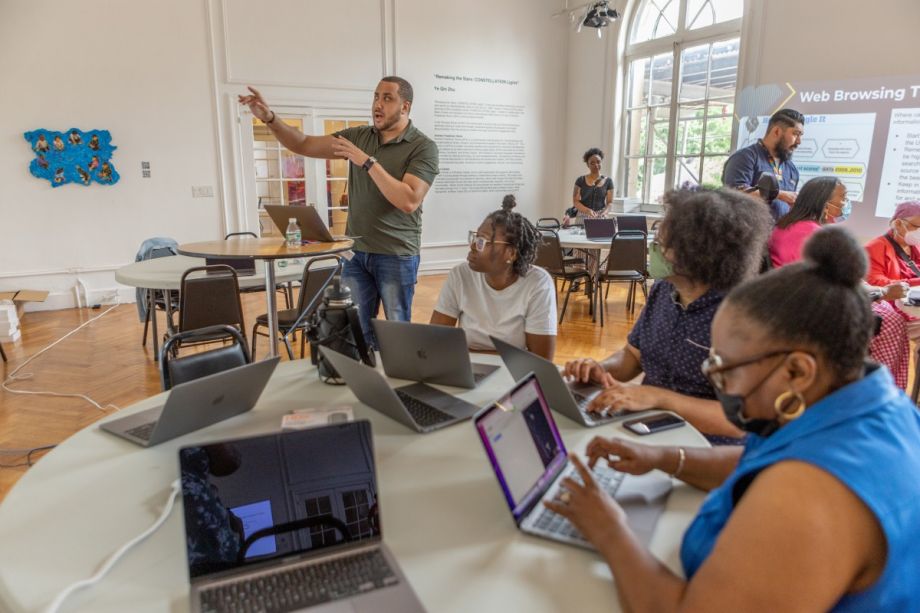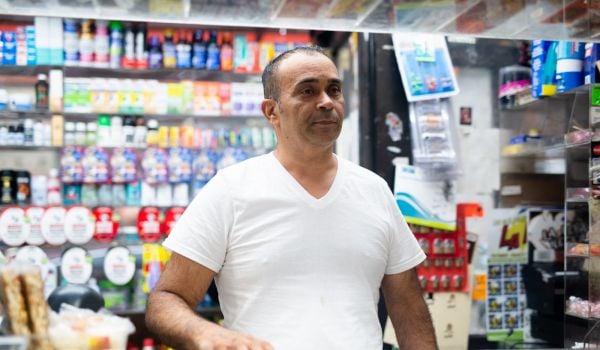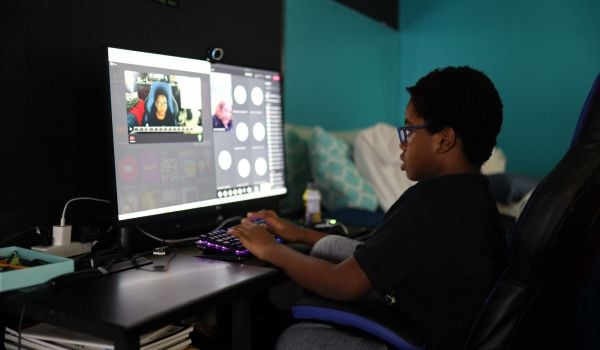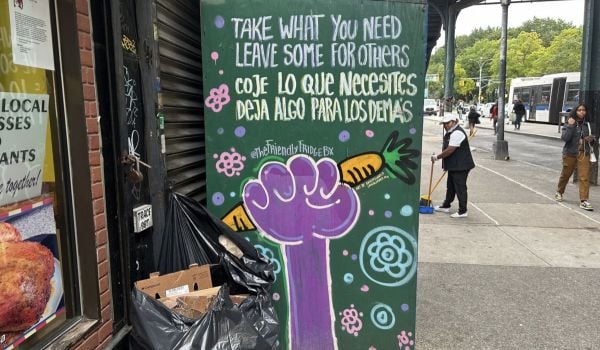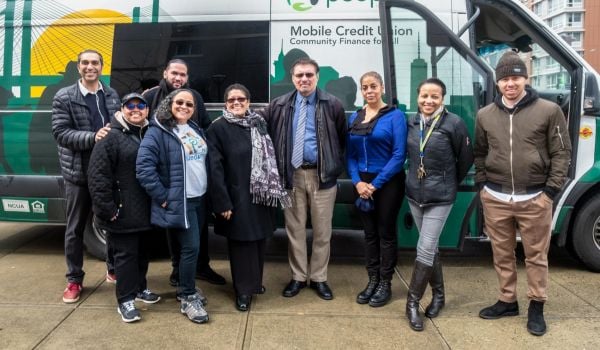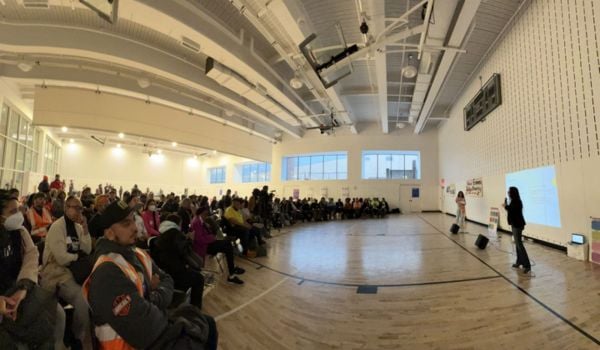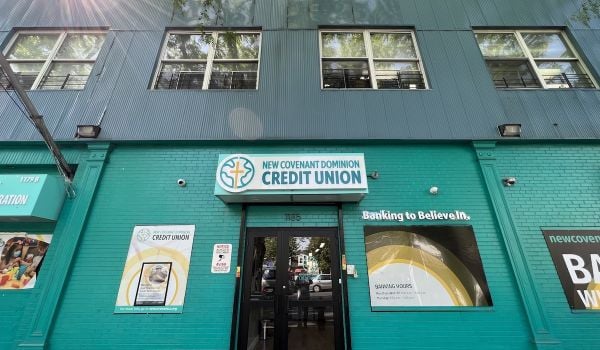About 38% of Bronx residents don’t have home broadband access, higher than the 29.5% average across the city. And an estimated 18.6% of borough residents don’t have internet access at all, according to city officials.
At the start of the COVID-19 pandemic, when that digital divide felt starker than ever, the Bronx Community Foundation gathered roughly 20 local institutions providing digital resources and services and started meeting every Wednesday morning. This summer, that group, the Bronx Digital Equity Coalition, debuted a major accomplishment: the Bronx Gigabit Center, a community space with high-speed internet, technology programming and small business development powered by New York’s LinkNYC public Wi-Fi network.
“The Digital Equity Coalition was thinking about this before there was a space and a place,” says Meisha Porter, The Bronx Community Foundation’s president and chief executive. “Now there is a space where we can bring innovative digital programs that are not only open to the community, they’re guided by the community.”
The Bronx Gigabit Center is also the result of larger investments New York City made in expanding public Wi-Fi access, in response to rising awareness around the city’s digital divide. “In 2014, we were telling the government that 40% of people in Manhattan didn’t have any internet,” says Clayton Banks, the chief executive of Silicon Harlem, host of the city’s first Gigabit Center, which served as a model for the new Bronx version. The company, founded in 2013 to advance technological infrastructure in the neighborhood, has for years advocated for free, indoor high-speed internet access hubs in low-income neighborhoods.

New York City's Gigabit Centers offer locals high-speed internet, technology programming, access to computers and small business development. (Photo by Gerri Hernandez)
LinkNYC launched in 2014 to begin addressing New York’s digital divide, replacing the city’s payphone network with wi-fi hotspots. The first kiosk was installed December 2015. The Link kiosks — which now make up one of the world’s largest public wi-fi-networks — provide free high-speed Wi-Fi, phone calls, device charging and access to social services, while displaying content like weather, transit info, public art and local information. There are nearly 2,000 installations, according to LinkNYC chief executive Nick Colvin, with a goal of 4,000 total by the end of 2026.
In its first year, LinkNYC installed kiosks in Harlem, giving the neighborhood a new, high-speed fiber network for public use. “It allowed not only to get on the internet, but to get on the internet with a gigabit of speed — it was faster to be online outdoors than it was indoors,” says Banks. “Since 2015 we have been advocating for the idea of pulling in the LinkNYC infrastructure to at least one building per borough.”
It took seven years for that to launch. In the meantime, the city released an Internet Master Plan to continue tackling the digital divide, COVID-19 hit, and the city introduced community-based providers to communities with limited broadband access.
When LinkNYC approached Silicon Harlem to finally test the concept of a physical community hub, the public-private partnership was able to hit the ground running. “Not only was I ready, I had already put together programs and things I knew would help,” Banks says.
New York’s first Gigabit Center opened in February 2022 at the Silicon Harlem Innovation Space for People. The space provides free public Wi-Fi access via the LinkNYC network, along with digital literacy training, coworking desks, after-school events, event space and public access to 20 computers.
Banks says access to high-speed makes a difference: “We’ve seen the problems when you’re on a slow network — local restaurants aren’t able to do what they need to do, small companies can’t keep a database,” he says.
As the Harlem Gigabit Center came together, the Bronx Digital Equity Coalition was hard at work distributing thousands of laptops, Chromebooks and MiFi devices (which serve as portable personal Wi-Fi hotspots) throughout the pandemic. Last year, the city’s proposal to place a gigabit center in the Bronx sparked community meetings to make it happen in partnership with the coalition and LinkNYC.
Several organizations within the coalition took the lead alongside the Bronx Community Foundation. The Knowledge House provides unemployed low-income youth and young adults free technical training and professional development services for employment in the tech sector. The Andrew Freedman Home, an initiative of the Mid-Bronx Senior Citizens Center, is a contemporary cultural space for Bronx artists. DreamYard, the largest arts provider in the Bronx, uses the arts, digital tools and social justice within schools and communities.
The Gigabit Center is housed at the Andrew Freedman Home. The partners will spearhead a larger collaboration within the coalition to determine programming. One focus that’s already emerged is the need for intergenerational support. “We’ve been very thoughtful of this center serving people from birth to senior citizens,” says Porter of the Bronx Community Foundation. “We’re thinking of different entry points into technology at different age ranges.”
Another focus of the center will be the Digital Library Project, now being created by the Andrew Freedman Home as an online platform to archive and showcase artwork, create educational content and host panel discussions. The overall goal is improving digital equity in the Bronx “by ensuring access to devices, a greater increase in internet connectivity and broadband, community-led digital training and support, and advocacy for long-term, sustainable solutions,” according to the team.
The space will offer access for 30 to 50 patrons at a time to use the resources, although the coalition is hoping to expand the center over time.
LinkNYC is planning for additional Gigabit Center locations in Queens, Brooklyn and Staten Island. “With LinkNYC coming through and deploying this brand-new, dark fiber network throughout the city, it makes sense to try to leverage that to seed centers throughout the city where people can access it,” Colvin says.
There’s still much to be done to address New York City’s digital divide. Since the launch of the Internet Master Plan in January of 2020, some advocates believe the city isn’t moving fast enough to expand access to low-cost, high-quality internet. “We need more centers like this,” Porter says, adding that should happen alongside alternatives like free internet in affordable housing.
After years of fighting for digital resources in marginalized neighborhoods, Banks is energized by the growing network of gigabit centers and the possibilities of these community spaces. “The digital divide is also about discriminatory practices that keep some people in spaces where internet is slow,” he says. “We’re going to stop that, and at least put up locations where anyone and everyone can come and access high-speed.”

Emily Nonko is a social justice and solutions-oriented reporter based in Brooklyn, New York. She covers a range of topics for Next City, including arts and culture, housing, movement building and transit.
Follow Emily .(JavaScript must be enabled to view this email address)

